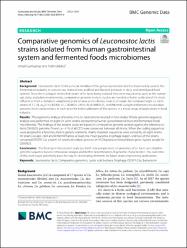| dc.contributor.author | Gümüştop, İsmail | |
| dc.contributor.author | Ortakçı, Fatih | |
| dc.date.accessioned | 2022-10-10T12:53:46Z | |
| dc.date.available | 2022-10-10T12:53:46Z | |
| dc.date.issued | 2022 | en_US |
| dc.identifier.issn | 2730-6844 | |
| dc.identifier.other | WOS:000836256300001 | |
| dc.identifier.uri | https://doi.org/10.1186/s12863-022-01074-6 | |
| dc.identifier.uri | https://hdl.handle.net/20.500.12573/1388 | |
| dc.description.abstract | Background: Leuconostoc lactis forms a crucial member of the genus Leuconostoc and has been widely used in the fermentation industry to convert raw material into acidified and flavored products in dairy and plant-based food systems. Since the ecological niches that strains of Ln. lactis being isolated from were truly diverse such as the human gut, dairy, and plant environments, comparative genome analysis studies are needed to better understand the strain differences from a metabolic adaptation point of view across diverse sources of origin. We compared eight Ln. lactis strains of 1.2.28, aa_0143, BIOML-A1, CBA3625, LN19, LN24, WIKIM21, and WiKim40 using bioinformatics to elucidate genomic level characteristics of each strain for better utilization of this species in a broad range of applications in food industry.
Results: Phylogenomic analysis of twenty-nine Ln. lactis strains resulted in nine clades. Whole-genome sequence analysis was performed on eight Ln. lactis strains representing human gastrointestinal tract and fermented foods microbiomes. The findings of the present study are based on comparative genome analysis against the reference Ln. lactis CBA3625 genome. Overall, a similar to 41% of all CDS were conserved between all strains. When the coding sequences were assigned to a function, mobile genetic elements, mainly insertion sequences were carried by all eight strains. All strains except LN24 and WiKim40 harbor at least one intact putative prophage region, and two of the strains contained CRISPR-Cas system. All strains encoded Lactococcin 972 bacteriocin biosynthesis gene clusters except for CBA3625.
Conclusions: The findings in the present study put forth new perspectives on genomics of Ln. lactis via complete genome sequence based comparative analysis and further determination of genomic characteristics. The outcomes of this work could potentially pave the way for developing elements for future strain engineering applications. | en_US |
| dc.language.iso | eng | en_US |
| dc.publisher | BMCCAMPUS, 4 CRINAN ST, LONDON N1 9XW, ENGLAND | en_US |
| dc.relation.isversionof | 10.1186/s12863-022-01074-6 | en_US |
| dc.rights | info:eu-repo/semantics/openAccess | en_US |
| dc.subject | Leuconostoc lactis | en_US |
| dc.subject | Comparative genomics | en_US |
| dc.subject | Lactic acid bacteria | en_US |
| dc.subject | Prophage | en_US |
| dc.subject | CRISPR-Cas | en_US |
| dc.subject | Bacteriocin | en_US |
| dc.title | Comparative genomics of Leuconostoc lactis strains isolated from human gastrointestinal system and fermented foods microbiomes | en_US |
| dc.type | article | en_US |
| dc.contributor.department | AGÜ, Yaşam ve Doğa Bilimleri Fakültesi, Biyomühendislik Bölümü | en_US |
| dc.contributor.institutionauthor | Gümüştop, İsmail | |
| dc.contributor.institutionauthor | Ortakçı, Fatih | |
| dc.identifier.volume | 23 | en_US |
| dc.identifier.issue | 1 | en_US |
| dc.identifier.startpage | 23 | en_US |
| dc.identifier.endpage | 61 | en_US |
| dc.relation.journal | BMC Genomic Data | en_US |
| dc.relation.publicationcategory | Makale - Uluslararası Hakemli Dergi - Kurum Öğretim Elemanı | en_US |


















